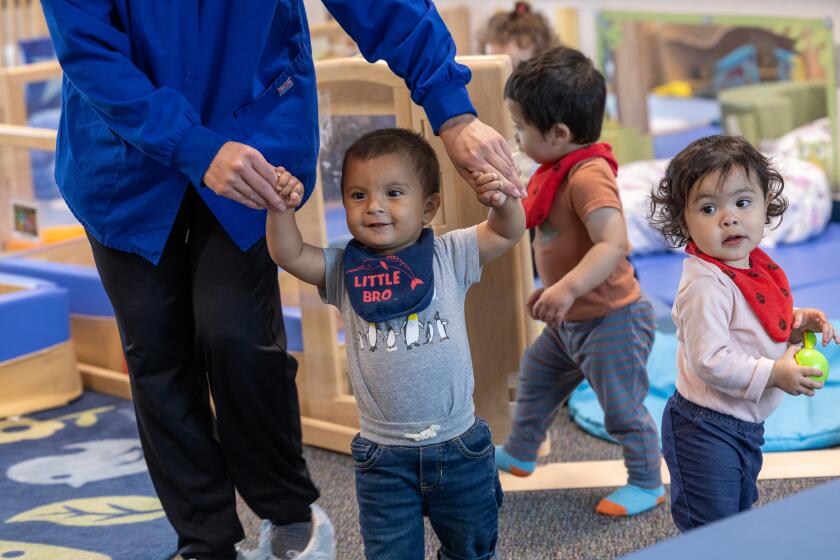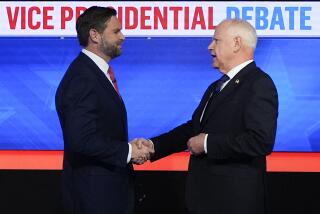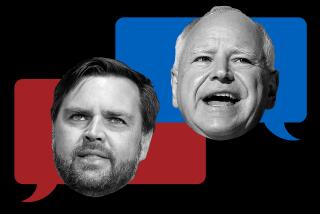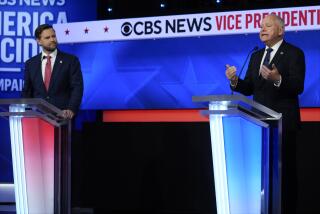Child care burst into the national spotlight at the Vance-Walz debate. Here’s why.

- Share via
The vice presidential candidates appeared to find some agreement during their Tuesday night debate over child care and paid family leave, in the longest and most in-depth campaign exchange about these issues to date.
In California and throughout the nation, these issues are key to improving quality of life for families that struggle to take time off to care for a newborn or ailing loved one, or to find affordable child care. Despite California’s significant investments in these areas, solutions still fall short of meeting the needs of many parents.
Republicans in Congress opposed President Biden’s ambitious 2021 plan to create an affordable child-care system and a universal paid family leave benefit. Yet Sen. JD Vance (R-Ohio) — former President Trump’s running mate — appeared to offer some support for both issues during the debate, voicing more moderate stances than he has in recent appearances.
“I think there is a bipartisan solution here because a lot of us care about this issue,” Vance said in response to a question from CBS News’ Margaret Brennan about a national paid leave program. As for the child-care crisis, Vance agreed with Minnesota Gov. Tim Walz — Vice President Kamala Harris’ running mate — that the government needs to spend more money.
“We’re going to have to induce more people to want to provide child-care options for American families because the reason it’s so expensive right now is because you’ve got way too few people providing this very essential service,” he said.
Engage with our community-funded journalism as we delve into child care, transitional kindergarten, health and other issues affecting children from birth through age 5.
But this diagnosis of the child-care market as a simple supply-side problem conflicts with how child-care experts see it.
“It reveals a fundamental misunderstanding of the child-care problem because it’s a broken market,” said Kathryn Anne Edwards, a labor economist and policy consultant who studies the child-care market.
Meanwhile, Vance’s solution — that the problem can be solved by offering families more choice of who can provide care for their children — is something the government already does. And under the current system, low-income families can use subsidies provided by the government to pay for the child care of their choice, including faith-based providers and care provided by a relative or friend.
Why is child care so expensive in the U.S.?
Child care is often described as a “broken market” for good reason: Child-care employees are some of the lowest-paid workers in the economy, at an average of $13.22 an hour, yet despite these low wages, the price of care is astronomical for families.
In California, for example, placing an infant in a private child-care center cost an average of $19,547 per year in 2021, according to the nonprofit Child Care Aware. That’s 15% of the median income for a married couple in the state, and 47.6% of the median income for a single parent.
Parents want Harris and Trump to prioritize affordable child care. Here’s where the presidential candidates’ track records stand on an overhaul of the system.
There are shortages of care in many places, including Los Angeles. But while Vance’s suggestion to expand supply might help more families find care, it is unlikely to significantly bring down costs.
That’s because the biggest problem is that child care costs more to provide than families can afford to pay. There aren’t many opportunities to trim costs, because the job of a child-care worker can’t be automated and employers can’t pay them any less. Workers are already fleeing the profession in search of higher wages in retail or fast food.
Meanwhile, Edwards says, there isn’t a line of people waiting to open child-care centers, because it’s not a profitable business.
Walz was not asked directly about child care, but addressed it in a question about paid family leave in somewhat vague terms, saying that child-care workers needed higher wages, and families more support to pay for care.
“You can’t expect the most important people in our lives to take care of our children or our parents to get paid the least amount of money,” he said. “And we have to make it easier for folks to be able to get into that business and then to make sure that folks are able to pay for that.”
In the Democratic plan, this would mean the federal government subsidizing care for more families.
Moving the child-care system from a “profit model” to a “reimbursement model,” in which the government pays child-care workers what it costs for them to provide the care is “the only solution for child care,” Edwards said. “Workers are not going to get cheaper, care is not going to get cheaper, and more people aren’t going to enter the market.”
What can families spend their child-care assistance on?
The government already provides subsidies to low-income families to help cover child-care costs; families can also attend free government-funded programs including Head Start and state preschools. Seventeen percent of children younger than 5 in California are served by government-subsidized child-care programs.
The federal government helps fund subsidies for families earning a maximum of 85% of their state’s median income — $104,544 for a family of four in California — through the Child Care and Development Block Grant, though many states cap it far lower.
During the debate, Vance said these subsidies fund only “one kind of child-care model. Let’s say you’d like your church, maybe, to help you out with child care. Maybe you live in a rural area or an urban area, and you’d like to get together with families in your neighborhood to provide child care in the way that makes the most sense. You don’t get access to any of these federal monies.”
This is false.
The government allows subsidies from the block grant program — in the form of vouchers to families — to be used for a variety of options — including both churches and care provided by a family member, friend or neighbor.
Tuesday night’s vice presidential debate was far more civil than last month’s clash between Kamala Harris and Donald Trump. Here are five takeaways.
The block grant was created as a “pro-choice federal program” by Republican President George H.W. Bush in 1990, said Bruce Fuller, a UC Berkeley professor of education and public policy. “The idea that the government disincentivizes using grandma is just incorrect.”
The problem is that the available vouchers are not nearly enough to meet the need. Of the nearly 6.3 million children ages 5 and younger in the U.S. whose families qualify for these subsidies, fewer than 840,000 receive it, or about 13%. There are often long lists of families waiting for a voucher to become available, including in California.
Meanwhile, families in the middle class are generally left paying sticker price.
What do Democrats propose as a child- care solution?
In September during an interview with members of the National Assn. of Black Journalists, Harris announced a child-care plan proposing that working families would not pay more than 7% of their income for child care.
The 7% cap idea isn’t new. It was proposed in 2021 in Biden’s Build Back Better bill, which Congress failed to pass.
The plan would have established a universal preschool program and capped a family’s child-care spending at 7% of income for anyone earning up to 250% of state median income. In California, that’s more than $277,000 for a family of four. Families earning more would have continued to pay full price. The overhaul would have cost an estimated $380 billion over six years.
Meanwhile, a separate proposal mentioned in the 2024 Democratic Party platform would instead cap family costs at $10 a day.
What do Republicans propose as a solution for child care?
Trump has not yet offered details for improving the child-care system, and the GOP campaign platform does not mention the issue.
“Child care is child care, it’s something you have to have in this country. You have to have it,” Trump told business leaders at the Economic Club of New York. His proposed tax on imports from foreign nations at higher levels, he said, would “take care” of such problems.
Vance supported this plan during the vice presidential debate. “I think what President Trump is saying is that when we bring in this additional revenue with higher economic growth, we’re going to be able to provide paid family leave, child-care options that are viable and workable for a lot of American families.
Why doesn’t the U.S. have national paid family leave?
The U.S. is one of only a few countries that does not guarantee paid leave nationally. Only Washington, D.C., and 13 states — including California — have passed such legislation. But the issue has bipartisan support from voters, according to Laura Narefsky, senior counsel for education and workplace justice at the National Women’s Law Center.
“This is not a polarizing issue for the American people, because at some point everyone has had to give or provide care,” Narefsky said.
Both Harris and Vance say they want to boost the popular child tax credit. The move could reduce child poverty rates, but could also be expensive.
Walz, who called paid family leave a “Day One” issue at the debate, touts a program he signed into law in Minnesota that will provide up to 20 weeks in a year for family and medical leave. The program, which will go into effect in 2026, will be funded by a payroll tax shared between workers and employers.
Vance did not say whether there should be a national law but agreed that paid family leave is a “bipartisan issue,” saying that his wife, an attorney, benefited from such a policy from her employer.
Currently, the federal government guarantees up to 12 weeks of unpaid but job-protected family and medical leave for eligible employees. In 2019, Trump also signed into law up to 12 weeks of paid parental leave for qualifying federal employees.
A national paid leave law has been shot down multiple times over the last several decades. An iteration of it made it into the failed Build Back Better bill before getting slashed.
And though Trump was the first Republican president to call for paid family leave, proposed programs during his administration did not receive bipartisan support in part because of their approaches to funding, which required families to borrow against their future selves.
A bill to provide 12 weeks of paid leave was reintroduced to Congress in May 2023.
How does paid family leave work in California?
California is home to the oldest paid family leave program in the country, which it has continued to tweak since its passage in 2002. Starting in January, the state is increasing how much a worker can collect while on family or medical leave as part of an effort to ensure low-wage workers can afford to take it.
Those who earn up to $60,000 a year will be able to get 90% of their income replaced while on family or medical leave in California, up from 60%. Workers who earn more will be able to collect 70%.
To help make up for the increase, California is removing the ceiling on the payroll tax, requiring higher-income earners to contribute the same 1.1% of their earnings as everyone else rather than capping the tax when their wages reach $153,164.
Though most states with paid leave offer up to 12 weeks, California lags behind. The state expanded paid family leave from six to eight weeks in 2020. Despite that, California does have one of the lowest barriers to entry, according to Jenya Cassidy, director of the California Work & Family Coalition. Anyone who earns at least $300 in a year and contributes to state disability insurance is eligible for the benefits.
This article is part of The Times’ early childhood education initiative, focusing on the learning and development of California children from birth to age 5. For more information about the initiative and its philanthropic funders, go to latimes.com/earlyed.
More to Read
Get the L.A. Times Politics newsletter
Deeply reported insights into legislation, politics and policy from Sacramento, Washington and beyond. In your inbox three times per week.
You may occasionally receive promotional content from the Los Angeles Times.
















